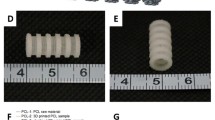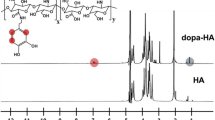Abstract
Tracheal restenosis is a major obstacle to successful tracheal replacement, and remains the greatest challenge in tracheal regeneration. However, there have been no detailed investigations of restenosis. The present study was performed to analyze the serial changes in recruited inflammatory cells and associated histological changes after tracheal scaffold implantation. Asymmetrically porous scaffolds, which successfully prevented tracheal stenosis in a partial trachea defect model, designed with a tubular shape by electrospinning and reinforced by 3D-printing to reconstruct 2-cm circumferential tracheal defect. Serial rigid bronchoscopy, micro-computed tomography, and histology [H&E, Masson’s Trichrome, IHC against α-smooth muscle actin (α-SMA)] were performed 1, 4, and 8 weeks after transplantation. Progressive stenosis developed especially at the site of anastomosis. Neutrophils were the main inflammatory cells recruited in the early stage, while macrophage infiltration increased with time. Recruitment of fibroblasts peaked at 4 weeks and deposition of α-SMA increased from 4 weeks and was maintained through 8 weeks. During the first 8 weeks post-transplantation, neutrophils and macrophages played significant roles in restenosis of the trachea. Antagonists to these would be ideal targets to reduce restenosis and thus play a pivotal role in successful tracheal regeneration.






Similar content being viewed by others
References
Hagberg C, Georgi R, Krier C. Complications of managing the airway. Best Pract Res Clin Anaesthesiol. 2005;19:641–59.
Wain JC Jr. Postintubation tracheal stenosis. Semin Thorac Cardiovasc Surg. 2009;21:284–9.
Daumerie G, Su S, Ochroch EA. Anesthesia for the patient with tracheal stenosis. Anesthesiol Clin. 2010;28:157–74.
Shapshay SM, Beamis JF Jr, Hybels RL, Bohigian RK. Endoscopic treatment of subglottic and tracheal stenosis by radial laser incision and dilation. Ann Otol Rhinol Laryngol. 1987;96:661–4.
Lee KE, Shin JH, Song HY, Kim SB, Kim KR, Kim JH. Management of airway involvement of oesophageal cancer using covered retrievable nitinol stents. Clin Radiol. 2009;64:133–41.
Perepelitsyn I, Shapshay SM. Endoscopic treatment of laryngeal and tracheal stenosis-has mitomycin C improved the outcome? Otolaryngol Head Neck Surg. 2004;131:16–20.
Tatekawa Y, Kawazoe N, Chen G, Shirasaki Y, Komuro H, Kaneko M. Tracheal defect repair using a PLGA-collagen hybrid scaffold reinforced by a copolymer stent with bFGF-impregnated gelatin hydrogel. Pediatr Surg Int. 2010;26:575–80.
Lee DY, Lee JH, Ahn HJ, Oh SH, Kim TH, Kim HB, et al. Synergistic effect of laminin and mesenchymal stem cells on tracheal mucosal regeneration. Biomaterials. 2015;44:134–42.
Kwon SK, Song JJ, Cho CG, Park SW, Kim JR, Oh SH, et al. Tracheal reconstruction with asymmetrically porous polycaprolactone/pluronic F127 membranes. Head Neck. 2014;36:643–51.
Lee DY, Park SA, Lee SJ, Kim TH, Oh SH, Lee JH, et al. Segmental tracheal reconstruction by 3D-printed scaffold: pivotal role of asymmetrically porous membrane. Laryngoscope. 2016;126:E304–9.
Kim DH, Choi CB, Yang WJ, Chung WH, Lee AJ, Chung DJ, et al. Tracheal replacement with fresh and cryopreserved aortic allograft in adult dog. J Surg Res. 2012;175:199–206.
Makris D, Holder-Espinasse M, Wurtz A, Seguin A, Hubert T, Jaillard S, et al. Tracheal replacement with cryopreserved allogenic aorta. Chest. 2010;137:60–7.
Gonfiotti A, Jaus MO, Barale D, Baiguera S, Comin C, Lavorini F, et al. The first tissue-engineered airway transplantation: 5-year follow-up results. Lancet. 2014;383:238–44.
Eardley KS, Zehnder D, Quinkler M, Lepenies J, Bates RL, Savage CO, et al. The relationship between albuminuria, MCP-1/CCL2, and interstitial macrophages in chronic kidney disease. Kidney Int. 2006;69:1189–97.
Lech M, Anders HJ. Macrophages and fibrosis: how resident and infiltrating mononuclear phagocytes orchestrate all phases of tissue injury and repair. Biochim Biophys Acta. 2013;1832:989–97.
Hinz B, Phan SH, Thannickal VJ, Galli A, Bochaton-Piallat ML, Gabbiani G. The myofibroblast: one function, multiple origins. Am J Pathol. 2007;170:1807–16.
Rockey DC, Housset CN, Friedman SL. Activation-dependent contractility of rat hepatic lipocytes in culture and in vivo. J Clin Invest. 1993;92:1795–804.
Tacke F, Zimmermann HW. Macrophage heterogeneity in liver injury and fibrosis. J Hepatol. 2014;60:1090–6.
Hinz B, Celetta G, Tomasek JJ, Gabbiani G, Chaponnier C. Alpha-smooth muscle actin expression upregulates fibroblast contractile activity. Mol Biol Cell. 2001;12:2730–41.
Lee SJ, Heo DN, Moon JH, Park HN, Ko WK, Bae MS, et al. Chitosan/polyurethane blended fiber sheets containing silver sulfadiazine for use as an antimicrobial wound dressing. J Nanosci Nanotechnol. 2014;14:7488–94.
Lee SJ, Heo DN, Moon JH, Ko WK, Lee JB, Bae MS, et al. Electrospun chitosan nanofibers with controlled levels of silver nanoparticles. Preparation, characterization and antibacterial activity. Carbohydr Polym. 2014;111:530–7.
Lee SJ, Heo DN, Park JS, Kwon SK, Lee JH, Kim WD, et al. Characterization and preparation of bio-tubular scaffolds for fabricating artificial vascular grafts by combining electrospinning and a 3D printing system. Phys Chem Chem Phys. 2015;17:2996–9.
Elliott MJ, De Coppi P, Speggiorin S, Roebuck D, Butler CR, Samuel E, et al. Stem-cell-based, tissue engineered tracheal replacement in a child: a 2-year follow-up study. Lancet. 2012;380:994–1000.
Bacon JL, Patterson CM, Madden BP. Indications and interventional options for non-resectable tracheal stenosis. J Thorac Dis. 2014;6:258–70.
Macchiarini P, Jungebluth P, Go T, Asnaghi MA, Rees LE, Cogan TA, et al. Clinical transplantation of a tissue-engineered airway. Lancet. 2008;372:2023–30.
Berg M, Ejnell H, Kovacs A, Nayakawde N, Patil PB, Joshi M, et al. Replacement of a tracheal stenosis with a tissue-engineered human trachea using autologous stem cells: a case report. Tissue Eng A. 2014;20:389–97.
Park DU, Yeom JK, Lee WJ, Lee KM. Assessment of the levels of airborne bacteria, Gram-negative bacteria, and fungi in hospital lobbies. Int J Environ Res Public Health. 2013;10:541–55.
Du XF, Kwon SK, Song JJ, Cho CG, Park SW. Tracheal reconstruction by mesenchymal stem cells with small intestine submucosa in rabbits. Int J Pediatr Otorhinolaryngol. 2012;76:345–51.
Suzuki T, Kobayashi K, Tada Y, Suzuki Y, Wada I, Nakamura T, et al. Regeneration of the trachea using a bioengineered scaffold with adipose-derived stem cells. Ann Otol Rhinol Laryngol. 2008;117:453–63.
Braga TT, Agudelo JS, Camara NO. Macrophages during the fibrotic process: M2 as friend and foe. Front Immunol. 2015;6:602.
Kzhyshkowska J, Gudima A, Riabov V, Dollinger C, Lavalle P, Vrana NE. Macrophage responses to implants: prospects for personalized medicine. J Leukoc Biol. 2015;98:953–62.
Arango Duque G, Descoteaux A. Macrophage cytokines: involvement in immunity and infectious diseases. Front Immunol. 2014;5:491.
Vernon MA, Mylonas KJ, Hughes J. Macrophages and renal fibrosis. Semin Nephrol. 2010;30:302–17.
Antoniades HN, Bravo MA, Avila RE, Galanopoulos T, Neville-Golden J, Maxwell M, et al. Platelet-derived growth factor in idiopathic pulmonary fibrosis. J Clin Invest. 1990;86:1055–64.
Cowper SE, Bucala R. Nephrogenic fibrosing dermopathy: suspect identified, motive unclear. Am J Dermatopathol. 2003;25:358.
Munger JS, Huang X, Kawakatsu H, Griffiths MJ, Dalton SL, Wu J, et al. The integrin alpha v beta 6 binds and activates latent TGF beta 1: a mechanism for regulating pulmonary inflammation and fibrosis. Cell. 1999;96:319–28.
Chaudhary NI, Roth GJ, Hilberg F, Muller-Quernheim J, Prasse A, Zissel G, et al. Inhibition of PDGF, VEGF and FGF signalling attenuates fibrosis. Eur Respir J. 2007;29:976–85.
Wynn TA. Cellular and molecular mechanisms of fibrosis. J Pathol. 2008;214:199–210.
Yang L, Pang Y, Moses HL. TGF-beta and immune cells: an important regulatory axis in the tumor microenvironment and progression. Trends Immunol. 2010;31:220–7.
Kobie JJ, Wu RS, Kurt RA, Lou S, Adelman MK, Whitesell LJ, et al. Transforming growth factor beta inhibits the antigen-presenting functions and antitumor activity of dendritic cell vaccines. Cancer Res. 2003;63:1860–4.
Park S, Park M, Kim BH, Lee JE, Park HJ, Lee SH, et al. Acute suppression of TGF-ss with local, sustained release of tranilast against the formation of fibrous capsules around silicone implants. J Control Release. 2015;200:125–37.
Kim YK, Que R, Wang SW, Liu WF. Modification of biomaterials with a self-protein inhibits the macrophage response. Adv Healthc Mater. 2014;3:989–94.
Ozcelik H, Vrana NE, Gudima A, Riabov V, Gratchev A, Haikel Y, et al. Harnessing the multifunctionality in nature: a bioactive agent release system with self-antimicrobial and immunomodulatory properties. Adv Healthc Mater. 2015;4:2026–36.
Acknowledgements
This research was supported by a grant of the Korea Health Technology R&D Project through the Korea Health Industry Development Institute (KHIDI), funded by the Ministry of Health & Welfare, Republic of Korea (Grant Number: HI14C0184 to S. K. K), by a Grant from the Seoul National University Hospital Research Fund (Grant Number: 0320140360 to S. K. K) and by the Education and Research Encouragement Fund of the Seoul National University Hospital (2016, to H. W. S).
Author information
Authors and Affiliations
Corresponding authors
Ethics declarations
Conflicts of interest
The authors declare no conflict of interest.
Ethical standard
All protocols were performed in accordance with the guidelines of the Animal Care Ethics Committee of Seoul National University Hospital (IACUC No. 15-0268-C1A1).
Rights and permissions
About this article
Cite this article
Ahn, HJ., Khalmuratova, R., Park, S.A. et al. Serial Analysis of Tracheal Restenosis After 3D-Printed Scaffold Implantation: Recruited Inflammatory Cells and Associated Tissue Changes. Tissue Eng Regen Med 14, 631–639 (2017). https://doi.org/10.1007/s13770-017-0057-y
Received:
Revised:
Accepted:
Published:
Issue Date:
DOI: https://doi.org/10.1007/s13770-017-0057-y




